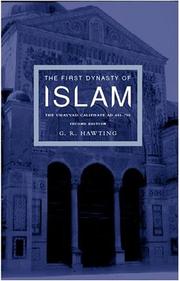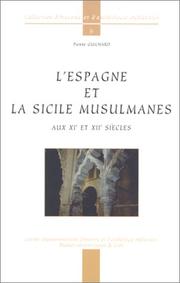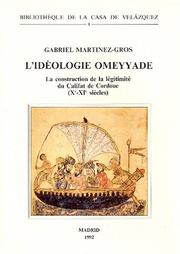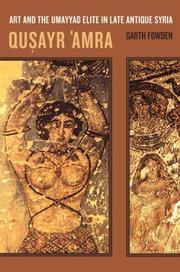| Listing 1 - 10 of 13 | << page >> |
Sort by
|

ISBN: 1134550596 0203137000 1280401451 0203170385 9786610401451 9780203170380 9780203137000 9780415240734 0415240735 0415240727 9780415240727 9781134550593 9781134550548 1134550545 9781134550586 1134550588 6610401454 0809313243 Year: 2000 Publisher: London New York Routledge
Abstract | Keywords | Export | Availability | Bookmark
 Loading...
Loading...Choose an application
- Reference Manager
- EndNote
- RefWorks (Direct export to RefWorks)
Gerald Hawting's book has long been acknowledged as the standard introductory survey of this complex period in Arab and Islamic history. Now it is once more made available, with the addition of a new introduction by the author which examines recent significant contributions to scholarship in the field. It is certain to be welcomed by students and academics alike.
Islamic Empire --- History --- Umayyad dynasty --- Omeyyades --- Empire islamique --- Histoire
Book
ISBN: 9780748695607 0748695605 9781474460446 1474460445 1474460453 Year: 2022 Publisher: Edinburgh
Abstract | Keywords | Export | Availability | Bookmark
 Loading...
Loading...Choose an application
- Reference Manager
- EndNote
- RefWorks (Direct export to RefWorks)
The Dome of the Rock is a shrine located on the Temple Mount in the Old City of Jerusalem. When was it built? What meanings was it meant to convey to viewers at the time of its construction? These are questions that have preoccupied historians of Islamic art and architecture, and numerous interpretations of the Dome of the Rock have been proposed. Marcus Milwright returns to one of the most important pieces of evidence: the mosaic inscriptions running around the two faces of the octagonal arcade. His detailed examination of the physical characteristics, morphology and content of these inscriptions provides new evidence about the chronology the building and the iconography of the Dome of the Rock.
Islamic inscriptions --- Architecture, Umayyad --- Art, Umayyad --- Inscriptions islamiques --- Architecture omeyyade --- Art omeyyade --- Qubbat al-Sakhrah (Mosque : Jerusalem) --- Islamic mosaics. --- Islamic mosaics --- Architecture, Umayyad. --- Art, Umayyad. --- Islamic inscriptions. --- Inschrift. --- Mosaik. --- Qubbat al-Ṣakhrah (Mosque : Jerusalem) --- Qubbat al-Ṣakhrah (Mosque : Jerusalem) --- Middle East --- Felsendom Jerusalem. --- Jérusalem - Ḥaram al-Sharīf. --- Felsendom Jerusalem --- Qubbat al-Ṣakhrah (Mosque : Jerusalem). --- Jérusalem --- Ḥaram al-Sharīf. --- Inschrift --- Mosaik --- Umayyad art --- Umayyad architecture --- Mosaics, Islamic --- Muslim mosaics --- Mosaics --- Inscriptions, Islamic --- Muslim inscriptions --- Inscriptions --- Jerusalem. --- Dome of the Rock (Mosque : Jerusalem) --- Moschea di Omar (Jerusalem) --- Cupola della Roccia (Mosque : Jerusalem) --- Mosque of Omar (Jerusalem) --- Ṣakhrah al-Musharrafah (Jerusalem) --- כיפת הסלע (מסגד : ירושלים) --- قبة الصخرة (مسجد : القدس) --- قبة الصخره --- al-Quds --- Baladīyat al-Quds --- Baladīyat al-Quds al-ʻArabīyah --- Bayt al-Maqdis --- Erusaghēm --- Gerusalemme --- Ierousalēm --- Ierusalim --- ʻIriyat Yerushalayim --- Israel --- Jerusalem Arab Municipality --- Jerusalem --- Jerusalén --- Jeruzalem --- Jeruzsálem --- Kouds --- Kuds --- Quds --- Ūrushalīm --- Yerushalayim --- Jérusalem - Ḥaram al-Sharīf.

ISBN: 2729706585 2729710655 Year: 2019 Volume: 6 Publisher: Lyon : Presses universitaires de Lyon,
Abstract | Keywords | Export | Availability | Bookmark
 Loading...
Loading...Choose an application
- Reference Manager
- EndNote
- RefWorks (Direct export to RefWorks)
Menacés par l'expansion de la Chrétienté, les prolongements européens de l'Islam brillent encore d'un vif éclat aux xie et xiie siècles. L'Islam sicilien se survit dans l'art « arabo-normand » de Palerme. À l'époque d'Averroès et des grands monuments de Séville, l'Islam andalou connaît encore une période prestigieuse sous les Almohades. Mais le fragile équilibre qui s'était instauré dans la péninsule ibérique entre la force féodale des royaumes chrétiens et les vastes constructions étatiques « hispano-maghrébines » est définitivement rompu avec la grande progression de la Reconquête dans la première moitié du xiiie siècle.
Arabs --- Arabes --- History. --- History --- Histoire --- Umayyad dynasty --- Hammudid dynasty --- Omeyyades --- Spain --- Sicily (Italy) --- Espagne --- Sicile (Italie) --- Religion --- chrétien --- musulman --- islam --- guerre de religions
Book
ISBN: 047290258X 0472122673 0472130285 Year: 2017 Publisher: Ann Arbor : University of Michigan Press,
Abstract | Keywords | Export | Availability | Bookmark
 Loading...
Loading...Choose an application
- Reference Manager
- EndNote
- RefWorks (Direct export to RefWorks)
The Most Noble of People presents a nuanced look at questions of identity in Muslim Spain under the Umayyads, an Arab dynasty that ruled from 756 to 1031. With a social historical emphasis on relations among different religious and ethnic groups, and between men and women, Jessica A. Coope considers the ways in which personal and cultural identity in al-Andalus could be alternately fluid and contentious. The opening chapters define Arab and Muslim identity as those categories were understood in Muslim Spain, highlighting the unique aspects of this society as well as its similarities with other parts of the medieval Islamic world. The book goes on to discuss what it meant to be a Jew or Christian in Spain under Islamic rule, and the degree to which non-Muslims were full participants in society. Following this is a consideration of gender identity as defined by Islamic law and by less normative sources like literature and mystical texts. It concludes by focusing on internal rebellions against the government of Muslim Spain, particularly the conflicts between Muslims who were ethnically Arab and those who were Berber or native Iberian, pointing to the limits of Muslim solidarity. Drawn from an unusually broad array of sources—including legal texts, religious polemic, chronicles, mystical texts, prose literature, and poetry, in both Arabic and Latin—many of Coope's illustrations of life in al-Andalus also reflect something of the larger medieval world. Further, some key questions about gender, ethnicity, and religious identity that concerned people in Muslim Spain—for example, women's status under Islamic law, or what it means to be a Muslim in different contexts and societies around the world—remain relevant today --
Muslims --- History. --- Ethnic identity. --- Social conditions. --- Umayyad dynasty. --- Spain --- History --- Mohammedans --- Moors (People) --- Moslems --- Muhammadans --- Musalmans --- Mussalmans --- Mussulmans --- Mussulmen --- Religious adherents --- Islam

ISBN: 8486839297 9788486839291 8490960976 Year: 2017 Volume: 8 Publisher: Madrid : Casa de Velázquez,
Abstract | Keywords | Export | Availability | Bookmark
 Loading...
Loading...Choose an application
- Reference Manager
- EndNote
- RefWorks (Direct export to RefWorks)
Nul n'est prophète parmi les siens. Muhammed le vérifia quand le clan dominant de sa propre tribu, les Omeyyades, rejeta la religion qu'il annonçait et le chassa de La Mecque. Vaincus, convertis du bout des lèvres, les Omeyyades devaient pourtant, peu après la mort du Prophète (632), s'emparer du Califat, c'est-à-dire de la direction de cet Islam dont ils n'avaient d'abord pas voulu, et conduire sa rapide expansion, de l'Indus à l'Atlantique. Mais tous n'avaient pas oublié leur péché originel. En 750, les Omeyyades sont renversés, et presque exterminés. Un des leurs réussit à fuir en Espagne, aux confins négligés de l'Empire. Deux siècles plus tard, contre toute attente, la puissance omeyyade s'y est affermie, tandis que leurs ennemis déclinent en Orient. Le temps semble venu de reprendre le Califat, ou du moins de le revendiquer en droit. Cette légitimité que leurs sujets andalous vont s'efforcer d'établir, non sans peine, est le thème de ce livre. Car si leur projet politique avortera, les Omeyyades auront, pour les besoins de leur idéologie, fondé les grands traits de la culture andalouse, l'une des plus brillantes de l'Islam et de l'Europe médiévale.
Muslims --- Musulmans --- History. --- Histoire --- Umayyad dynasty --- Omeyyades --- Spain --- Córdoba (Spain) --- Espagne --- Cordoue (Espagne) --- History --- Córdoba (Spain) --- Umayyad dynasty. --- Córdoba --- Qurṭubah (Spain) --- Cordoue (Spain) --- Cordova (Spain) --- Kordova (Spain) --- Corduba (Spain) --- قرطبة (Spain) --- Cordoue --- islam --- politique --- Omeyyades d'Espagne --- XIème siècleEspagne --- califat --- Al-Andalus --- Xème siècle --- Califat --- Islam et politique --- 711-1516 --- 10e siècle --- Historiographie --- Andalousie (Espagne) --- Politique et gouvernement --- Jusqu'à 1479

ISBN: 1282357026 9786612357022 0520929608 1597348449 9780520929609 9780520236653 0520236653 9781597348447 1417573716 9781417573714 9781282357020 6612357029 0520236653 Year: 2004 Publisher: Berkeley, Calif. University of California Press
Abstract | Keywords | Export | Availability | Bookmark
 Loading...
Loading...Choose an application
- Reference Manager
- EndNote
- RefWorks (Direct export to RefWorks)
From the stony desolation of Jordan's desert, it is but a step through a doorway into the bath house of the Qusayr 'Amra hunting lodge. Inside, multicolored frescoes depict scenes from courtly life and the hunt, along with musicians, dancing girls, and naked bathing women. The traveler is transported to the luxurious and erotic world of a mid-eighth-century Muslim Arab prince. For scholars, though, Qusayr 'Amra, probably painted in the 730s or' 740s, h'as proved a mirage, its concreteness dissolved by doubts about date, patron, and meaning. This is the first book-length contextualization of the mysterious monument through a compelling analysis of its iconography and of the literary sources for the Umayyad period. It illuminates not only the way of life of the early Muslim elite but also the long afterglow of late antique Syria.
Arabic poetry --- Mural painting and decoration, Umayyad --- Umayyad mural painting and decoration --- History and criticism --- Foreign influences. --- Qusayr ʻAmrah (Jordan : Dwelling) --- History and criticism. --- Arabic poetry - 622-750 - History and criticism. --- abbasid. --- abd al malik. --- al azraq. --- al buldn. --- alois musil. --- amir. --- ancient art. --- apodyterium. --- arab. --- arabic poetry. --- arabic. --- architecture. --- art history. --- bath house. --- baths. --- captive woman. --- court life. --- dancing girls. --- decorative arts. --- desert. --- dynasty. --- femininity. --- frescoes. --- gender. --- hunt. --- hunting lodge. --- iconography. --- iran. --- islam. --- jordan. --- khusraw. --- late antiquity. --- middle east. --- monument. --- murals. --- musicians. --- muslim. --- mythology. --- negus. --- nonfiction. --- ode. --- persia. --- prince. --- princess. --- qusayr amra. --- roderic. --- royal court. --- self fashioning. --- shaykh musa. --- syria. --- umayyad. --- women. --- Qusayr Amrah (Jordan : Dwelling)
Book
ISBN: 9004469206 9004469133 Year: 2022 Publisher: Leiden, The Netherlands : Koninklijke Brill NV,
Abstract | Keywords | Export | Availability | Bookmark
 Loading...
Loading...Choose an application
- Reference Manager
- EndNote
- RefWorks (Direct export to RefWorks)
In Articulating the Ḥijāba, Mariam Rosser-Owen analyses for the first time the artistic and cultural patronage of the ‘Amirid regents of the last Cordoban Umayyad caliph, Hisham II, a period rarely covered in the historiography of al-Andalus.; Readership: All interested in the history, literature, art, architecture and archaeology of medieval Islamic Iberia, relations with the Maghrib, the organisation of artistic workshops, and the patronage and meaning of artworks
Spain Kings and rulers. --- Spain Civilization 711-1516. --- Spain --- Kings and rulers. --- Civilization --- History of art / art & design styles --- The arts --- Umayyad dynasty. --- Muslims --- History. --- Co´rdoba (Spain) --- Córdoba (Spain)
Book
ISBN: 9789004383166 9004383166 9004383174 Year: 2019 Publisher: Leiden ; Boston : Brill,
Abstract | Keywords | Export | Availability | Bookmark
 Loading...
Loading...Choose an application
- Reference Manager
- EndNote
- RefWorks (Direct export to RefWorks)
In Early Sunnī Historiography , Tobias Andersson presents the first full-length study of the earliest Islamic chronological history extant: the Tārīkh ( Chronicle ) of the Basran ḥadīth scholar and historian Khalīfa born Khayyāṭ al-ʿUṣfurī (d. 240/854). The book examines how Khalīfa worked as a historian in terms of his social and intellectual context, selection of sources, methods of compilation, arrangement of material and narration of key themes in comparison to the wider historiographical tradition. It shows how Khalīfa’s affiliation with the early Sunnī ḥadīth scholars of Basra is reflected in his methods and concerns throughout the Tārīkh , while also highlighting similarities to other histories compiled by ḥadīth scholars of the third/ninth century.
ʻUṣfūrī, Khalīfah ibn Khayyāṭ, --- Umayyad dynasty --- History --- Islamic Empire --- Omayyad dynasty --- Omeyyades (dynastie). --- בית אומיה --- بنو أموية --- היסטוריה --- التاريخ --- האימפריה האסלאמית --- الإمبراطوريّة الإسلامية --- Arab countries --- Arab Empire --- Empire, Islamic --- Middle East --- Muslim Empire --- Omeyyades --- الإمبراطورية الإسلامية --- Islam Empire
Book
ISBN: 0228013259 Year: 2022 Publisher: Montreal, Canada : McGill-Queen's University Press,
Abstract | Keywords | Export | Availability | Bookmark
 Loading...
Loading...Choose an application
- Reference Manager
- EndNote
- RefWorks (Direct export to RefWorks)
Bringing together recent scholarship on Islamic art, architecture, and archaeology being conducted in Canada and by Canadian scholars, Made for the Eye of One Who Sees provides the first survey of the Canadian contributions to this developing field. It covers topics from across the Islamic world dating from the eighth century to the present.
Museums. --- Africa. --- Central Asia. --- Charles Trick Currelly. --- Egypt. --- Fatimid. --- Henri Bergson. --- Henri Matisse. --- Indian Subcontinent. --- Iran. --- Islam. --- Mamluk. --- Middle East. --- Mughal. --- Royal Ontario Museum. --- Safavid. --- Syria. --- Timurid. --- Umayyad. --- aesthetics. --- amulet. --- aniconism. --- architecture. --- art history. --- calligraphy. --- ceramics. --- collecting. --- drainpipes. --- epigraphy. --- exhibition design. --- giraffe. --- iconography. --- lustre. --- manuscript painting. --- mosque. --- new media. --- palace. --- paper. --- writing. --- Islamic countries. --- Ontario
Book
ISBN: 9782356681676 2356681671 2356680756 Year: 2021 Publisher: Lyon : MOM Éditions,
Abstract | Keywords | Export | Availability | Bookmark
 Loading...
Loading...Choose an application
- Reference Manager
- EndNote
- RefWorks (Direct export to RefWorks)
La mission archéologique syro-française de Qinnasrin a mené ses travaux de 2008 à 2010 sur le site d'al-'Iss (Syrie du Nord, région d'Alep), dans l'ensemble du bourg et dans ses environs immédiats, grâce aux financements de la Commission des fouilles du ministère de l'Europe et des Affaires étrangères, de la Fondation Max van Berchem, du CNRS et de la Direction générale des Antiquités et Musées de Syrie. Attestée depuis la fin du IIIe millénaire avant notre ère, Qinnasrin est un nœud routier et militaire important, qui domine une plaine fertile, aux confins de la steppe et des zones d'agriculture irriguée. Renommée Chalcis par les Grecs, elle est, à l'époque romaine, le siège d'une royauté et frappe monnaie. Elle joue un rôle essentiel dans le système de fortification de la Syrie du Nord mis en place par Justinien face aux Perses, puis lors de la conquête de la Syrie du Nord par les armées de l'islam. Étroitement liée à Alep, elle décline, à son profit, à partir du milieu du xe siècle et tombe dans l'oubli vers le XIVe siècle. Cet ouvrage dresse un état des lieux et une synthèse des sources textuelles et archéologiques. Il présente la documentation constituée par les prospections pédestre et géophysique, les premières fouilles archéologiques jamais menées sur le site, l'inventaire des blocs architecturaux et la collecte de matériel. Plusieurs découvertes permettent de rendre compte de l'importance acquise par la ville, tant aux périodes les plus anciennes qu'aux époques grecque, romaine ou islamique. Pour la première fois, un scénario de l'évolution morphologique de la ville et de ses transformations est proposé. Ce second volume de la série consacrée à Qinnasrin livre un portrait inédit d'un site remarquable et largement méconnu.
Fouilles archéologiques --- Chalcis ad Belum (ville ancienne) --- Excavations (Archeology) --- Architecture, Ancient --- Syria --- Antiquities --- Archaeology --- archéologie --- épigraphie --- morphologie urbaine --- Syrie du Nord --- âge du Bronze --- période hellénistique --- Empire romain --- Antiquité tardive --- période omeyyade --- période abbasside --- Moyen Âge --- églises d’Orient --- conquête musulmane --- fortification --- céramique --- sigillée --- archaeology --- epigraphy --- urban morphology --- Northern Syria --- Bronze Age --- hellenistic period --- roman empire --- Late Antiquity --- umayyad period --- abbasid period --- Middle Age --- oriental churches --- muslim conquest --- pottery --- sigillata --- Fouilles archéologiques --- Antiquité tardive. --- Qinnasrīn (Extinct city) --- Antiquities.
| Listing 1 - 10 of 13 | << page >> |
Sort by
|

 Search
Search Feedback
Feedback About UniCat
About UniCat  Help
Help News
News